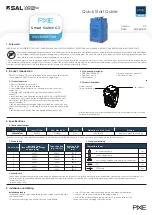
D-Link CLI Reference Guide
Page 228
qos aggregate-policer
The
qos aggregate-policer
Global Configuration mode command defines the policer parameters that can be
applied to multiple traffic classes within the same policy map. To remove an existing aggregate policer, use the
no
form of this command.
Syntax
qos aggregate-policer aggregate-policer-name committed-rate-bps excess-burst-byte exceed-action
{
drop
|
policed-dscp-transmit
} [
dscp
dscp
]
no qos aggregate-policer
Parameters
•
aggregate-policer-name
— Specifies the name of the aggregate policer.
•
committed-rate-bps
— Specifies the average traffic rate (CIR) in bits per second (bps).
•
excess-burst-byte
— Specifies the normal burst size (CBS) in bytes.
•
drop
— Indicates that when the rate is exceeded, the packet is dropped.
•
policed-dscp-transmit
— Indicates that when the rate is exceeded, the DSCP of the packet is remarked.
•
dscp
— Specifies the value that the DSCP would be remarked. If unspecified, the DSCP would be remarked
according to the policed-DSCP map as configured by the
qos map policed-dscp
Global Configuration mode
command.
Default Configuration
No aggregate policer is define.
Command Mode
Global Configuration mode
User Guidelines
Policers that contain
set
or
trust
Policy-map Class Configuration commands or that have ACL classifications
cannot be attached to an output interface.
Define an aggregate policer if the policer is shared with multiple classes.
Policers in one port cannot be shared with other policers in another device; traffic from two different ports can be
aggregated for policing purposes.
An aggregate policer can be applied to multiple classes in the same policy map; An aggregate policer cannot be
applied across multiple policy maps.
This policer can also be used in Cascade police to make a cascade policer.
An aggregate policer cannot be deleted if it is being used in a policy map. The
no police aggregate
Policy-map
Class Configuration command must first be used to delete the aggregate policer from all policy maps.
Policing uses a token bucket algorithm. CIR represents the speed with which the token is removed from the
bucket. CBS represents the depth of the bucket.
Summary of Contents for DXS-3250 - xStack Switch - Stackable
Page 12: ...Page 11 ...
Page 46: ...ACL Commands Page 45 ...
Page 68: ...Address Table Commands Page 67 ...
Page 124: ...Ethernet Configuration Commands Page 123 ...
Page 134: ...GVRP Commands Page 133 ...
Page 144: ...IGMP Snooping Commands Page 143 ...
Page 158: ...IP Addressing Commands Page 157 Console config ip helper address 172 16 9 9 49 53 ...
Page 166: ...IP Addressing Commands Page 165 ...
Page 186: ...Line Commands Page 185 ...
Page 194: ...Management ACL Commands Page 193 ...
Page 200: ...PHY Diagnostics Commands Page 199 ...
Page 208: ...Port Monitor Commands Page 207 ...
Page 216: ...Power over Ethernet Commands Page 215 ...
Page 272: ...RMON Commands Page 271 ...
Page 334: ...Spanning Tree Commands Page 333 ...
Page 428: ...VLAN Commands Page 427 ...
Page 466: ...802 1x Commands Page 465 ...
















































